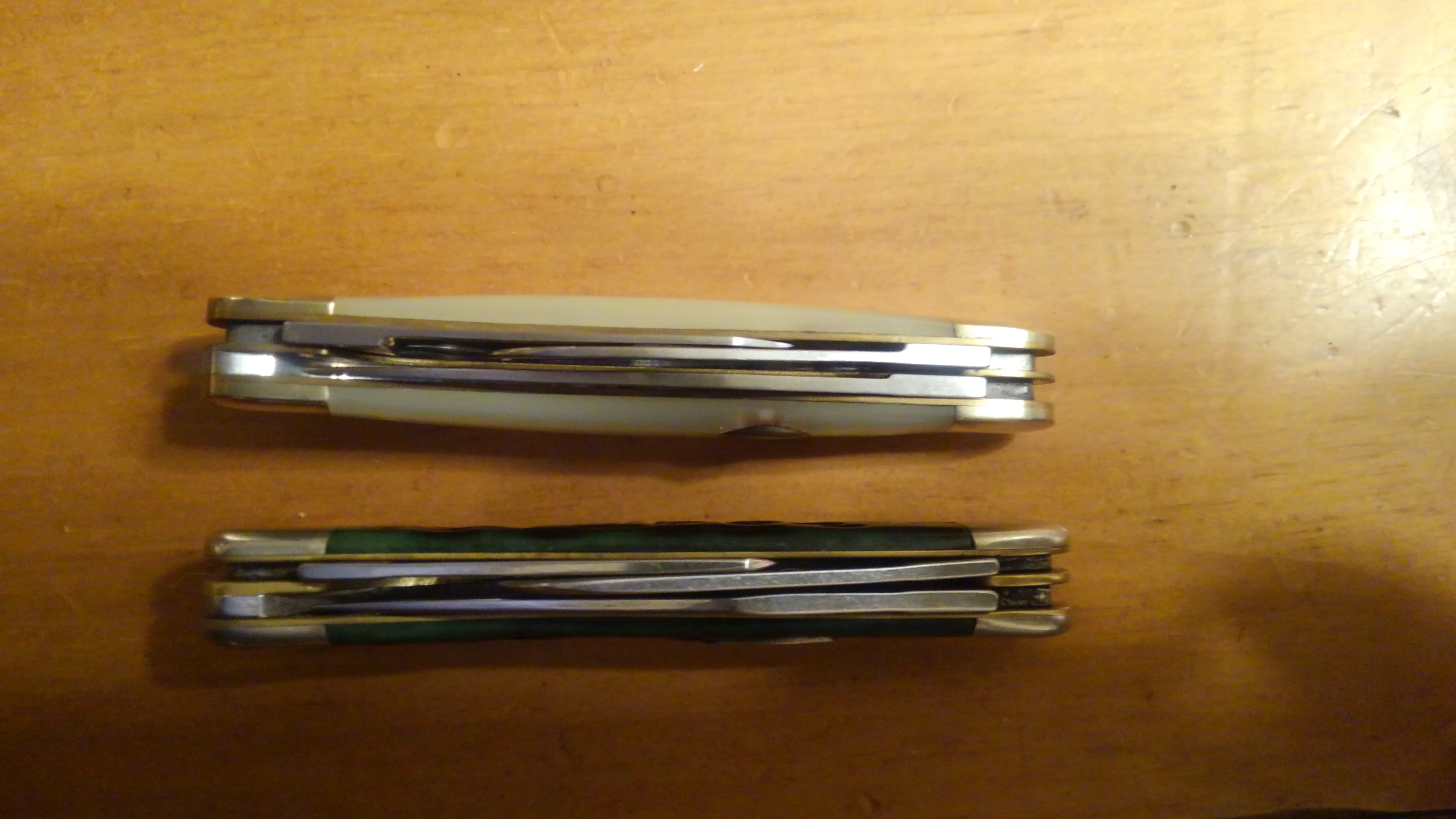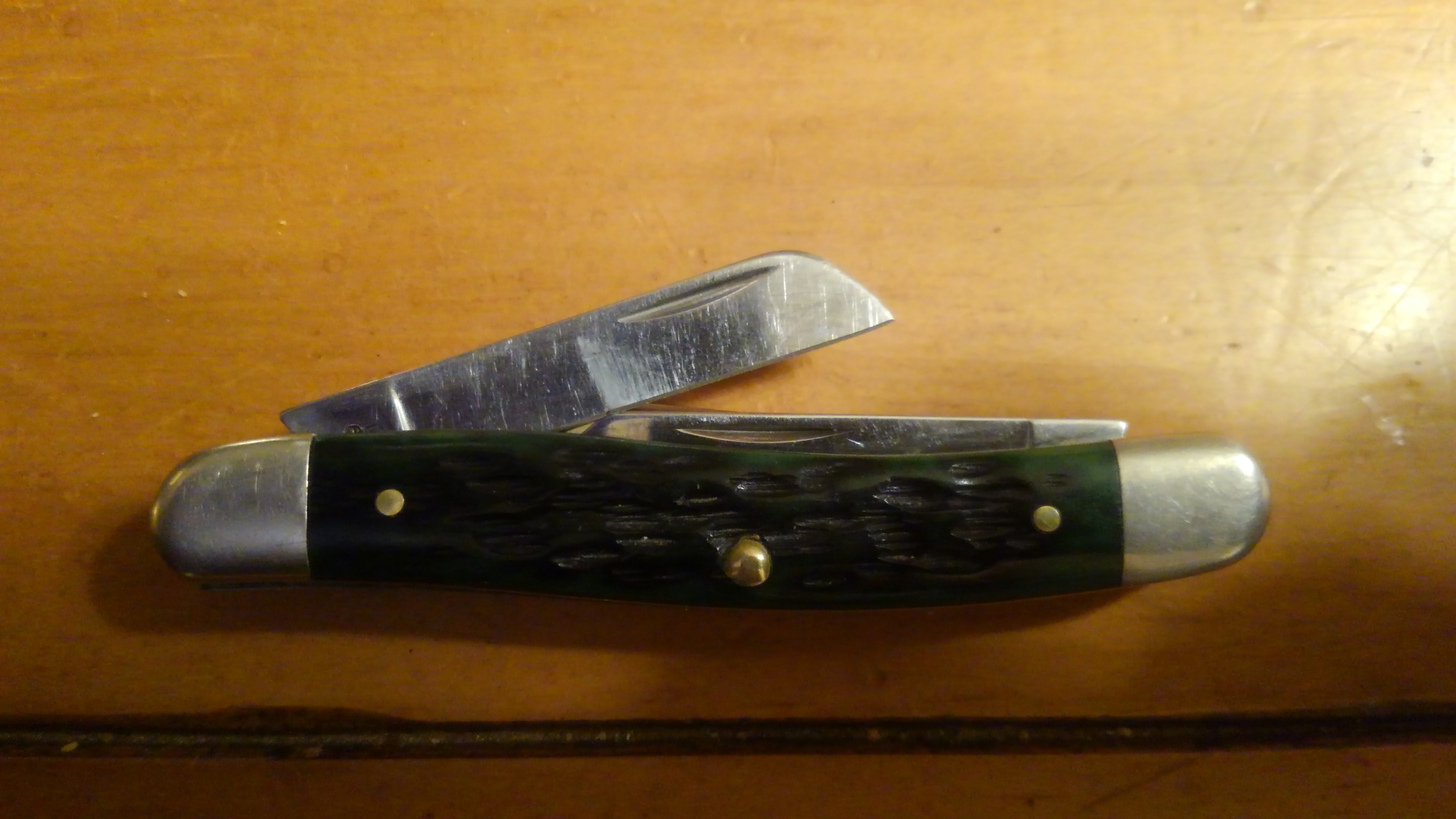Preface: I have attempted to take fair and honest pictures but I am no professional photographer.
The pocketknives in these pictures are:
-Jeep Stockman (JP-1009). Imitation Mother of Pearl. Unknown manufacturer but it does have "made in China" stamped on it.
-Case Medium Stockman (6318 SS). Pocket Worn Bermuda Green Bone.
1. I genuinely could never find a use for the third blade (major problem).
2. Because you have two blades competing for the space of one spring, you end up bending one of the two blades. This can be corrected in one of two manners. Either making each blade short enough they only reach the half way point or grinding the blades thinner and orienting them in opposite directions as to "nest" together. Case did neither of these (major problem).
Note the "nesting" effect created that allows two blades to fit in the space of one spring.

This next picture shows the different methods used by each company. Note the obvious bend in the top right blade of the Case Stockman.

This image shows one blade open and the bent blade closed. Note that the blade wants to return to it's "proper" location which is inhibited when both blades are closed, thus causing the bent blade.

In this image, I placed the blade next to a straight edge to show the blade has begun to bend. Because the blade is bent while closed, it has begun to bend permanently.

3. Due to both blades wanting to occupy the same space, when closing either blade, one cutting edge will hit the top of already closed blade. This will dent and dull your cutting edge. Due to the speed created by the force of the spring, your pocketknife will close because the cutting edge will hit the top of the second blade and "deflect" into the closed position. However, this is not true in every instance. In fact, your blade could remain partially open and the user not realize it, potentially causing a hazard in the pocket or next time you grab the pocketknife (major problem).
4. The blades being forced together will eventually scar the mirror-like finish Case is known for. This will occur quickly, even directly from retailer. For me, this pocketknife was a carry knife (minor problem) but may be a major problem for collectors.
In this image, we can see problem #3 and #4. Note that I have purposely slowed the speed of the closing action to depict that the cutting edge can in fact come to rest on the top of the second blade, thus not properly closing.

5. In practical use, this spey blade seems too small to castrate livestock, which is it's intended purpose. However I am no rancher and would have to seek advice from a professional (major problem).
After a few years of being a customer I have come to the conclusion that Case is in fact a very smart and thoughtful company in the research, design, and execution of their products. So the question becomes, why did Case choose to manufacture this pattern in this manner?
The pocketknives in these pictures are:
-Jeep Stockman (JP-1009). Imitation Mother of Pearl. Unknown manufacturer but it does have "made in China" stamped on it.
-Case Medium Stockman (6318 SS). Pocket Worn Bermuda Green Bone.
1. I genuinely could never find a use for the third blade (major problem).
2. Because you have two blades competing for the space of one spring, you end up bending one of the two blades. This can be corrected in one of two manners. Either making each blade short enough they only reach the half way point or grinding the blades thinner and orienting them in opposite directions as to "nest" together. Case did neither of these (major problem).
Note the "nesting" effect created that allows two blades to fit in the space of one spring.

This next picture shows the different methods used by each company. Note the obvious bend in the top right blade of the Case Stockman.

This image shows one blade open and the bent blade closed. Note that the blade wants to return to it's "proper" location which is inhibited when both blades are closed, thus causing the bent blade.

In this image, I placed the blade next to a straight edge to show the blade has begun to bend. Because the blade is bent while closed, it has begun to bend permanently.

3. Due to both blades wanting to occupy the same space, when closing either blade, one cutting edge will hit the top of already closed blade. This will dent and dull your cutting edge. Due to the speed created by the force of the spring, your pocketknife will close because the cutting edge will hit the top of the second blade and "deflect" into the closed position. However, this is not true in every instance. In fact, your blade could remain partially open and the user not realize it, potentially causing a hazard in the pocket or next time you grab the pocketknife (major problem).
4. The blades being forced together will eventually scar the mirror-like finish Case is known for. This will occur quickly, even directly from retailer. For me, this pocketknife was a carry knife (minor problem) but may be a major problem for collectors.
In this image, we can see problem #3 and #4. Note that I have purposely slowed the speed of the closing action to depict that the cutting edge can in fact come to rest on the top of the second blade, thus not properly closing.

5. In practical use, this spey blade seems too small to castrate livestock, which is it's intended purpose. However I am no rancher and would have to seek advice from a professional (major problem).
After a few years of being a customer I have come to the conclusion that Case is in fact a very smart and thoughtful company in the research, design, and execution of their products. So the question becomes, why did Case choose to manufacture this pattern in this manner?


